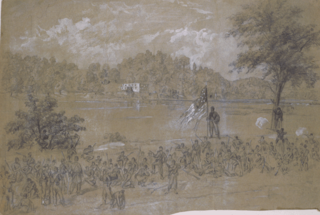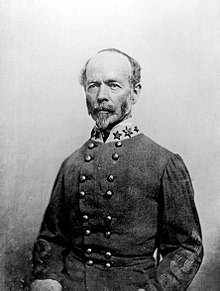
The Army of Northern Virginia was the primary military force of the Confederate States of America in the Eastern Theater of the American Civil War. It was also the primary command structure of the Department of Northern Virginia. It was most often arrayed against the Union Army of the Potomac.

The First Battle of Bull Run, also called the Battle of First Manassas by Confederate forces, was the first major battle of the American Civil War. The battle was fought on July 21, 1861, in Prince William County, Virginia, just north of what is now the city of Manassas and about thirty miles west-southwest of Washington, D.C. The Union Army was slow in positioning themselves, allowing Confederate reinforcements time to arrive by rail. Each side had about 18,000 poorly trained and poorly led troops. The battle was a Confederate victory and was followed by a disorganized post-battle retreat of the Union forces.

The Confederate Army of the Potomac, whose name was short-lived, was under the command of Brig. Gen. P. G. T. Beauregard in the early days of the American Civil War. Its only major combat action was the First Battle of Bull Run. Afterwards, the Army of the Shenandoah was merged into the Army of the Potomac with Gen. Joseph E. Johnston, the commander of the Shenandoah, taking command. The Army of the Potomac was renamed the Army of Northern Virginia on March 14, 1862, with Beauregard's original army eventually becoming the First Corps, Army of Northern Virginia.

The Battle of Hoke's Run, also known as the Battle of Falling Waters or Battle of Hainesville, took place on July 2, 1861, in Berkeley County, Virginia as part of the Manassas campaign of the American Civil War. Notable as an early engagement of Confederate Colonel Thomas J. Jackson and his Brigade of Virginia Volunteers, nineteen days before their famous nickname would originate, this brief skirmish was hailed by both sides as a stern lesson to the other. Acting precisely upon the orders of a superior officer about how to operate in the face of superior numbers, Jackson's forces resisted General Robert Patterson's Union forces briefly and then slowly retreated over several miles.

The Battle of Blackburn's Ford took place on July 18, 1861, in the Confederate state of Virginia, as part of the Manassas campaign of the American Civil War. Union general Irvin McDowell's Army of Northeastern Virginia was marching south towards the Confederate capital of Richmond, and encountered the Confederate Army of the Potomac under the command of P. G. T. Beauregard. McDowell sent troops from Daniel Tyler's division to probe the Confederate defenses along Bull Run Creek to locate the Confederate left flank. At Blackburn's Ford, the Union troops attempted to cross but Confederate fire broke up the attack. The repulse at Blackburn's Ford led McDowell to seek to attack the Confederates at a different point along their line, leading to the First Battle of Bull Run three days later.

The Battle of Shepherdstown, also known as the Battle of Boteler's Ford, took place September 19–20, 1862, at Boteler's Ford along the Potomac River, during the Maryland campaign of the American Civil War. After the Battle of Antietam on September 17, General Robert E. Lee and the Confederate Army of Northern Virginia withdrew across the Potomac. Lee left a rearguard commanded by Brigadier General William N. Pendleton at Boteler's Ford. On September 19, elements of the Union V Corps dueled with Pendleton's artillery before pushing a short distance across the river at dusk. Pendleton inaccurately informed Lee that all of the artillery of the rearguard had been captured. On the morning of September 20, the Confederates counterattacked with A. P. Hill's Light Division, forcing the Union units back across the Potomac. One Union unit, the 118th Pennsylvania Infantry Regiment, did not withdraw at the same time as the others and suffered heavy losses. Lee's army continued its retreat into the Shenandoah Valley after the battle.
The Stonewall Brigade of the Confederate Army during the American Civil War, was a famous combat unit in United States military history. It was trained and first led by General Thomas J. "Stonewall" Jackson, a professor from Virginia Military Institute (VMI). His severe training program and ascetic standards of military discipline turned enthusiastic but raw recruits into an effective military organization, which distinguished itself from the First Battle of Bull Run in 1861 to Spotsylvania Court House in 1864. Its legacy lives on in the 116th Infantry Brigade, which bears the unofficial nickname "Stonewall Brigade," and in several living history reenactment groups.

Cadmus Marcellus Wilcox was a career United States Army officer who served in the Mexican–American War and also was a Confederate general during the American Civil War.

Thomas Taylor Munford was an American farmer, iron, steel and mining company executive and Confederate colonel and acting brigadier general during the American Civil War.

The 33rd Virginia Infantry Regiment was an infantry regiment raised in the Commonwealth of Virginia for service in the Confederate States Army during the American Civil War. It was a part of the famed "Stonewall Brigade," named for General Stonewall Jackson.

James Dearing was a Confederate States Army officer during the American Civil War who served in the artillery and cavalry. Dearing entered West Point in 1858 and resigned on April 22, 1861, when Virginia seceded from the Union. Dearing was mortally wounded at the Battle of High Bridge during the Appomattox Campaign of 1865, making him one of the last officers to die in the war. Despite serving as a commander of a cavalry brigade and using the grade of brigadier general after he was nominated to that grade by Confederate President Jefferson Davis, Dearing did not officially achieve the grade of brigadier general because the Confederate Senate did not approve his nomination. His actual permanent grade was colonel.
The following Union Army units and commanders fought in the Second Battle of Bull Run, also known as the Second Battle of Manassas, of the American Civil War. The Confederate order of battle is listed separately. Order of battle compiled from the army organization during the battle, the casualty returns and the reports.

Julius H. Stahel-Számwald was a Hungarian soldier who emigrated to the United States and became a Union general in the American Civil War. After the war, he served as a U.S. diplomat, a mining engineer, and a life insurance company executive. He received the Medal of Honor for gallantry in action at the Battle of Piedmont in 1864.

Philip St. George Cocke was a brigadier general in the Confederate States Army during the first year of the American Civil War. He is best known for organizing the defense of Virginia along the Potomac River soon after the state's secession from the Union. He commanded troops in the Battle of Blackburn's Ford and the First Battle of Bull Run in July 1861 before becoming despondent and committing suicide.

The 2nd Virginia Infantry Regiment was an infantry regiment raised in today's western Virginia and what became West Virginia during the American Civil War for service in the Confederate States Army. It would combine with the 4th, 5th, 27th, and 33rd Virginia infantry regiments and the Rockbridge Artillery Battery and fight as part of what became known as the Stonewall Brigade, mostly with the Army of Northern Virginia.

The Bull Run campaign, also known as the Manassas campaign, was a series of military engagements in the Eastern Theater of the American Civil War in 1861.
The Department of Pennsylvania was a large military unit in the Union army at the outset of the American Civil War. Established on April 27, 1861, its territory consisted of Pennsylvania, Delaware, and all of Maryland not embraced in the Department of Annapolis and the Department of Washington. Its remnants were absorbed into the short-lived Department of the Shenandoah on July 19, 1861, which also absorbed the Department of Maryland on July 25, and on August 24 was merged into the Department of the Potomac.
The 2nd Pennsylvania Infantry Regiment was a Union army regiment that participated in the early part the American Civil War.

The 6th Louisiana Infantry Regiment served in the Confederate States Army during the American Civil War. It was part of the Louisiana Tigers. Formed in June 1861 at Camp Moore, it fought in Jackson's Valley campaign, the Battle of Gaines Mill, the Second Battle of Bull Run and its related actions, and the Battle of Antietam in 1862. The next year, it fought at the Second Battle of Fredericksburg, the Battle of Salem Church, the Second Battle of Winchester, and the Battle of Gettysburg before being overrun at the Second Battle of Rappahannock Station. It spent 1864 fighting in Grant's Overland campaign and with Jubal Early in the Valley campaigns of 1864. The regiment fought in the Battle of Hatcher's Run and the Battle of Fort Stedman in early 1865 before surrendering after the Battle of Appomattox Court House in April. It began its service with 916 men and ended with 52.
The Battle of Lewinsville was an engagement fought between a Confederate States Army force of 400 to 500 men and the United States Army units numbering about 1,800 men near Lewinsville, Virginia in Fairfax County, Virginia, on September 11, 1861. The Union reconnaissance was in force which led to the engagement was part of the operations of Major General General McClellan in the last half of 1861 in northern Virginia. After taking control of the Washington defenses after the First Battle of Bull Run, McClellan strengthened the ring of forts and outposts defending the immediate vicinity of Washington, D.C. He also planned to cautiously extend the area of northern Virginia under Union control. Scouting, surveying and mapping missions were among the early actions implementing this plan. Minor battles occurred, which were notable for their effects on military and political actions and leadership appointments in the nascent war.














